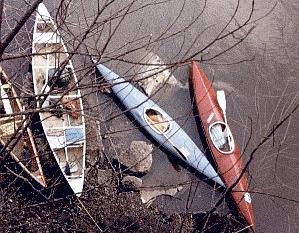
My blue kayak, between a canoe and a red
Phoenix Appalachian, Bureau Creek, IL, 1982
 My blue kayak, between a canoe and a red Phoenix Appalachian, Bureau Creek, IL, 1982 |
When I started college in the autumn of 1976, our family belonged to a small canoe club based in Lemont, Illinois. It had the dubious moniker of "KKK" which stood for Keepataw Kanoe Klub. During my first year away at school, events transpired of which I had no knowledge, but when I came home for the week of spring break in 1977, I was informed that we were helping a fellow canoe club member do some work in his garage. To my surprise and delight, the "work" turned out to be making a kayak. During the previous few months, several of the canoe club members made a mold from a discontinued Sawyer slalom model and it was now ready for production. At this time, our club became the "KKKK," which included Kayak.
For less than $100, our share of the mold and the construction materials, we could make our dream boat. We decided to make two: one for me and one for my sister, Vicky. When we started work that March, it was still the middle of winter and we had to work inside because the temperature was too low for the Fiberglas resin to set. Of course, then we had to deal with the rather potent fumes. We used Kevlar and regular Fiberglas cloth, as well as resin and gel coat. At the time we began making the boats, kayaks were commercially available in two common colors: red on top with white bottom, and natural, which was a sort of pale tan. We had yellow, blue and white tints for our boats. I decided I wanted a light blue one, while my sister opted for green. Her boat would come to be called "The Iguana."
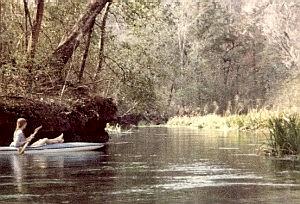 Valerie on the Ichatucknee River, FL, 1983 |
Through trial and error, we worked on making that first kayak. I had to go back to school and finish the semester, but when I got home for the summer, it was full speed ahead on the construction of my boat. During this period, we acquired a tiny red kayak very cheaply at a garage sale. It was a Klepper Minor, designed to be used by children under 150 pounds. My mother removed the seat so that she could fit into it.
On June 15 of that year, my mother, sister and I left on a 3-week camping trip with the two boats. We had never tried the little Klepper and the Fiberglas of my new boat had still not cured enough to be used. Our destination was WATER. Actually, we planned on heading out to Cape Hatteras first, then down the coast into Florida. The first night we stopped at a small state park in Tennessee that had a lake. There was only enough time before nightfall for Vicky to try the little red boat. She almost got lost in the dark. The next morning I tried it in a dense fog. It handled just like I imagined it would. No tipping over and it moved with an ease never possible in a canoe.
A couple days later, we were on Cape Hatteras, my kayak had cured long enough and we were ready for the maiden voyage. Vicky and I launched at the Oregon Inlet marina and headed out into the Atlantic. I discovered that my beautiful new boat leaked like the proverbial sieve, so we made the trip a short one. Back at the campsite, we did some emergency work on the underside with extra gel coat to fill in the thousands of tiny pinholes in the resin. The remedy worked and my boat is still watertight to this day.
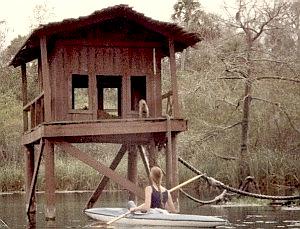 Encounter with a monkey on the Weeki Wachi River, FL, 1983 |
After that, we took kayaks many places, from the Desplaines River, which was less than a mile from our house in Lemont, to rivers and lakes all over Illinois, Missouri, Indiana, and Florida. We even went on Lake Michigan. There were many enjoyable times and numerous hilarious incidents. We got lost on a small river in central Illinois and had to stop paddling, when we kept running into trees and rocks in the dark, and ask at a nearby farmhouse for directions. My mother once managed to get the two points of her kayak caught between the pilings of a bridge on the Desplaines River and, as if on a spit, flipped right over. We eventually retrieved the car keys from the rocks under four feet of fast moving water. I had a fish jump into my lap while paddling the Kankakee River. We went "cross country" kayaking, which involved traveling through several lakes, portaging short distances, using a section of a river, then dragging the kayaks through a muddy little creek only inches deep to get back to our starting place. I've kayaked inside a cave, through culverts, on flood rivers and beaver ponds, and even through a small zoo.
While I was attending the University of Illinois, my kayak remained back in Lemont. During the spring break of 1980, my mother and sister took the green and blue boats to the Current River area of Missouri. We had earlier enjoyed these fast-flowing crystal clear rivers. However, this time the water was even higher than usual and my sister lost The Iguana in a tangle of trees. The force of the water folded the boat and she had to break it apart to escape. There were only a couple of other kayaks made from our club's original mold, partly because the enthusiasm of many people diminished when they found out how much work was required for the construction process. One boat lost its seat when we were surfing on Lake Michigan. I suspect my blue kayak may be the last survivor.
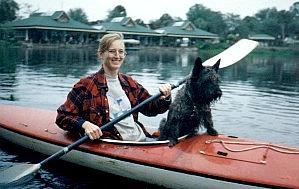 Frisky touring Silver Springs, FL, Dec., 1994, in a borrowed kayak |
When we started kayaking, my miniature schnauzer, Samantha, was nine years old. She tolerated all our outdoor activities, but was never overly enthusiastic. However, being a good sport and loyal companion, she learned to sit in the kayak with me and took several trips in her later years. Frisky, on the other hand, LOVES to kayak, perhaps because she grew up with the boat. She knows the rules: wait until the human is in the boat BEFORE jumping in, stay seated in the boat, stay out of the way of the paddle, don't walk on the deck, wait until told it is okay to jump out of the boat, etc. In spite of this, her excitement causes her to frequently disobey. It is a good thing she can swim.
Although the kayak remained in Illinois when I first moved to Tallahassee to begin graduate work, by my second year there I had a place to store the boat and so took it down with me. Since it weighs less than 30 pounds, I can carry and even lift the kayak onto cartop carriers, eliminating the need for a partner to go paddling. I spent many restful hours exploring the nearby swamps, spring-fed rivers, and lakes. Sometimes I would take a book and just paddle out into the middle of a lake or cypress swamp and read. I still think that Florida has some of the best kayak paddling available.
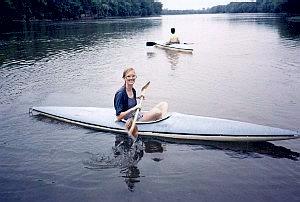 Kankakee River, IL, 1988, with Larry |
Nowadays, it is commonplace to see kayaks used for recreational boating, fishing, and even photography. They can often be rented at places that used to have only canoes and paddleboats. Over the years, my boat has done everything I imagined it could. I've occasionally used a spray skirt on large bodies of water with high waves, but mostly just enjoy the open cockpit, where I can keep a dog, my camera, get in and out of the boat for swimming, or just let my legs hang out into the water. Paddling at nearly water level gives one a perspective as close to a duck's view as physically possible. Very often, animals don't regard my small boat as a threat and I've enjoyed close encounters with beaver, mink, raccoons, geese, swans, and other shoreline visitors. I've never learned the Eskimo roll. In fact, it would be impossible in my flat-bottomed boat. I've also never tipped over under normal circumstances. The only spills were taken when I used my boat for surfing big waves on Lake Michigan, something for which a slalom kayak was never designed. Whether paddling alone, with a partner or two, or with a canoe club, the speed and maneuverability of this small boat makes any trip utterly enjoyable. I've paddled several different kayaks over the years, but always find my own to be the best. My kayak is still a dream come true.